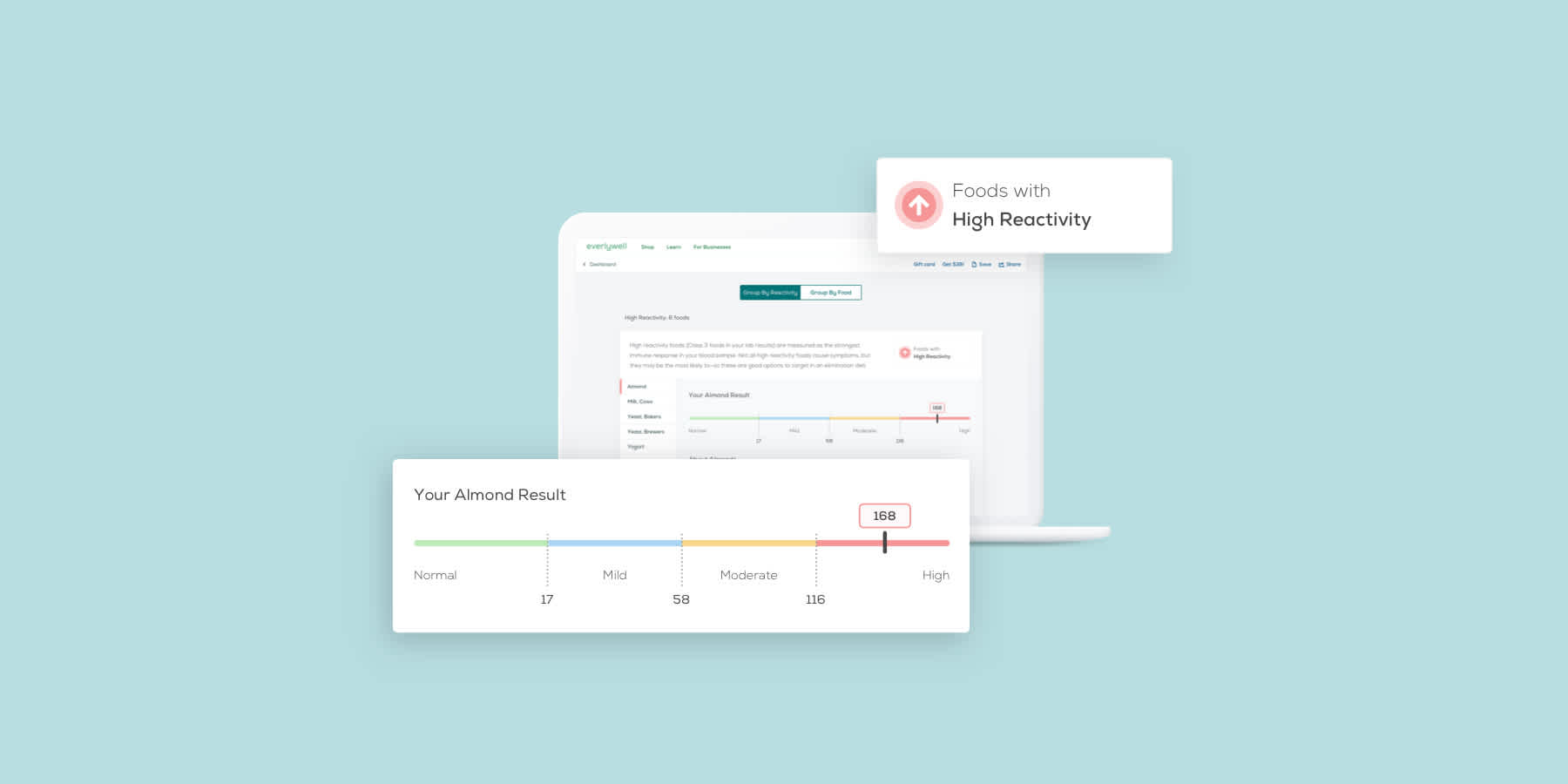
IgG food test results interpretation
Medically reviewed on June 14, 2022 by Jordan Stachel, M.S., RDN, CPT. To give you technically accurate, evidence-based information, content published on the Everlywell blog is reviewed by credentialed professionals with expertise in medical and bioscience fields.
Table of contents
- Why do my IgG levels matter?
- How do IgG tests work?
- What do IgG results look like?
- What should I do after getting my IgG results?
- IgG testing with Everlywell
- Related content
Many people can spend months (even years) trying to understand which foods trigger responses like rashes and stomach rumbles. So, if you decide to examine your reactivities to foods with an IgG food sensitivity panel, it’s important to understand the results—and your next steps.
Here’s our guide to IgG food test results interpretation (for IgG testing from the convenience of home, try the Everlywell Food Sensitivity Test).
Why do my IgG levels matter?
Before reading any IgG test results, you should know just what role IgG plays in the body’s digestion and how it factors into a food sensitivity test.
IgG, or immunoglobulin G, is an antibody released by the immune system. If the body perceives this food as dangerous, it will release IgG antibodies to “fight off” the particles, creating a food sensitivity.
Unfortunately, this immune response often triggers uncomfortable symptoms that can pop up hours after eating [1]. Typical symptoms can include:
- Digestive issues (diarrhea, constipation, bloating, acid reflux)
- Inflammation (rashes, joint pain, mild swelling)
- Headaches
- Fatigue and weakness
- Anxiety and irritability
- Brain fog
How do IgG tests work?
If you can’t determine which foods your body is sensitive to, taking an IgG food antibody assessment can help you decide which foods to prioritize in a two-part elimination diet.
While each licensed testing lab may have slightly different procedures, most follow the same IgG testing protocol. Testing steps include [2]:
- Blood withdrawal – Whether at home or in a healthcare provider’s office, all IgG tests require a blood sample since IgG is released in the bloodstream. For the Everlywell Food Sensitivity Test, a finger prick is all that’s necessary for sample collection.
- In vitro exposure – Once a licensed lab receives the blood sample, they’ll isolate it into individual testing vessels. Each testing vessel is then mixed with particles from a particular food to test sensitivity.
- IgG reaction assessment – Each blood sample is then tested for its reactive IgG levels in response to each food. The higher the IgG levels, the higher the potential for a food sensitivity.
Once you receive the results, you can see if your body has an atypical IgG reaction to a particular food that may be behind symptoms you experience. Trying an elimination diet and add-back challenge for specific foods is an option before permanently altering one's diet.
What do IgG results look like?
At first, IgG test results may look a little confusing. To interpret them, you just need to understand the IgG reaction scale.
Test results will give each tested food a “score”. This score refers to the blood’s IgG levels in reaction to that food, often ranked numerically as well as across:
- No reactivity – A normal and non-sensitive IgG response
- Mild reactivity – A slightly elevated IgG response, usually with few symptoms
- Moderate reactivity – A somewhat elevated IgG response, usually with mild symptoms
- High reactivity – A strong IgG response, indicating a possible sensitivity
Just remember—symptoms do not always align with IgG test results. You might eat eggs every day in peace but receive a “high reactivity” score for eggs. Likewise, you may always get stomach cramps after eating dairy, but your test may show no IgG elevation for dairy. Ultimately, it’s important to pair your test results with a temporary elimination diet to determine what specific foods you’re sensitive to.
What should I do after getting my IgG results?
So, you’ve read your results and checked them twice. Now, what do you do?
After you receive IgG results, it’s time to put the results to work with a temporary elimination diet.
Temporary elimination diets remove and reintroduce potentially problematic foods from the diet to see if you still experience symptoms. Thanks to the IgG food sensitivity test results, you’ll have a pretty good idea of which foods to eliminate first in a temporary elimination diet.
The process can look something like this:
- Eliminate – Depending on your experience, you can consider which foods are worth eliminating from the diet to assess for possible sensitivities. Usually, high- or moderate-reactivity foods are a good place to start.
- Wait – Wait at least four weeks before reintroducing any eliminated foods. This lets the digestive system “reset,” ridding any traces of these foods in the bloodstream or related symptoms.
- Reintroduce – After four weeks, slowly reintroduce one of these foods to the diet for three days or longer. Do not reintroduce multiple eliminated foods at once. Otherwise, you may not know exactly which ones create symptoms.
- Evaluate – Finally, it’s time to assess. Which reintroduced foods left you bloated? Which came back without a hitch? If symptoms continue regardless of the elimination, you can repeat the process with other suspected foods.
IgG testing with Everlywell
Food sensitivity testing can help you learn which foods you may want to prioritize for a two-part elimination diet. If you’re facing chronic digestive pain or have experienced a severe allergic reaction, consider taking the first step toward finding a solution with the Everlywell Food Sensitivity Test.
Related content
Dairy alternatives to consider for dairy-related issues
IgG vs. IgE antibodies: understanding the differences
References
1. Food Allergy vs. Food Intolerance: Symptoms, Causes & Prevention. Cleveland Clinic. URL. Accessed June 14, 2022.
2. Lavine E. Blood testing for sensitivity, allergy or intolerance to food. CMAJ. 2012;184(6):666-668.